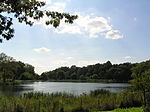1939 PGA Championship
The 1939 PGA Championship was the 22nd PGA Championship, held July 9–15 at Pomonok Country Club in Queens, New York. Then a match play championship, Henry Picard won his only PGA Championship, defeating Byron Nelson with a birdie at the 37th hole. It was the second of his two major titles; he won the Masters in 1938. Nelson won the U.S. Open three months earlier and the next PGA Championship in 1940. Beginning in 1939, he made five finals in six PGA Championships, and won his second title in 1945. Picard had not trailed and led by two as late as the 26th hole, but the match was squared on the 29th green and Nelson led by one after 32 holes. Both birdied the par-5 33rd and Picard sank a curling putt from over twenty feet (6 m) for par to halve the 34th hole and stay one back. They halved the par-3 35th at par and both had birdie putts on the 36th green. Nelson missed his from ten feet (3 m) feet while Picard sank his from three to square up the match. On the extra hole, both again had birdie putts: Picard made his from ten feet while Nelson missed his from six.Defending champion Paul Runyan lost in the quarterfinals to Dick Metz. This PGA Championship was held during the 1939 New York World's Fair. The golf course no longer exists; Pomonok Country Club disbanded in 1949 and the property was developed for residences.
Excerpt from the Wikipedia article 1939 PGA Championship (License: CC BY-SA 3.0, Authors).1939 PGA Championship
Parsons Boulevard, New York Queens
Geographical coordinates (GPS) Address Nearby Places Show on map
Geographical coordinates (GPS)
| Latitude | Longitude |
|---|---|
| N 40.734 ° | E -73.81 ° |
Address
Parsons Boulevard 67-11
11365 New York, Queens
New York, United States
Open on Google Maps




